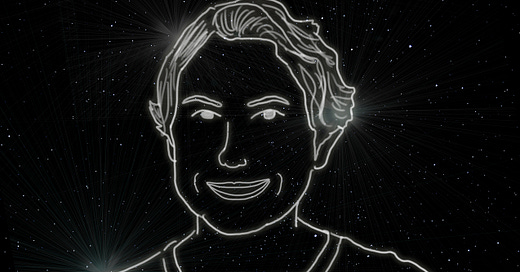Conversations #27 - Shannon Mattern
Epistemology and Knowledge manifest through design at different scales
Author and Professor at the University of Pennsylvania, Shannon Mattern—
Hello Eclectic Spacewalkers,
Last month we had the pleasure of speaking with Shannon Mattern, an author, and professor at the University of Pennsylvania.
“Epistemology and Knowledge manifest through design at different scales.”
Shannon’s research has had a profound impact on me and many other interdisciplinary scholars. She teaches and writes about infrastructures of all types, where she focuses on media architectures and spatial epistemologies. Her books have featured histories and critical discourse about maps, libraries, urban communication infrastructures, and other urban intelligences.
Shannon is a pithy, and prolific, writer who after reading gets a sense of the profoundness of the critique but also writes in an agreeable and actionable way. It is accessible, thought-provoking, and inspiring.
Scents of Spatial Order, Sensing Technical Lands
“Spice is perhaps a useful synesthetic metaphor for thinking about and
designing technical lands, which are so often represented through flat,
abstracted maps, aerial photos, and diagrams. Spices adds sensory depth
and texture that can unfold over time. As temporal media, they are used to
preserve and embalm. Through their cultural histories, spices blend local
terroir and global systems. And they, too, often emerge from technical
lands—from plantations and factory farms—yet they remind us that these
spaces of abstracted logic and visual order are atmospheric and reliant on
organic bodies and ecologies, who are themselves, in turn, transformed by
the technical apparatus that order them.”
“The humble drinking fountain can tell us much about a society’s attitudes towards health, hygiene, equity, and virtue, and about its understanding of public goods and civic responsibilities.
Ultimately, it’s unsurprising that the ambitious projects in New York and Minneapolis encountered obstacles. Drinking fountains are seemingly modest, even innocuous urban amenities that nonetheless require the coordination — and, ideally, the approbation — of myriad administrative stakeholders, from parks departments to public art commissions, from water and sewer to landscape maintenance to homeless services. 45 Whether made from Aberdeen granite or stainless steel, whether ensconced in a leafy urban park or tucked into a nook in the local library, the drinking fountain constitutes a nexus of civic infrastructures and economies and ecosystems. And as media scholar Joanna Zylinska has argued, water infrastructures are particularly potent means of thinking through politics. “At a time when lofty yet disembodied notions of democracy and freedom are running thin,” she writes, “we need to work on developing more grounded and more fluid modes of political thinking and action, modes that take our relations with the environment seriously.… Perceiving water as the elemental medium, before it is turned into a resource, an industrial product, or a background to modern economies, needs to be the first step on this journey.” 46 Grounded, embodied, and anything but lofty, the drinking fountain reveals much about the charged politics of public spaces, and about the public things that, again to quote Bonnie Honig, “furnish the world of democratic life.”
Shannon has also published four books: The New Downtown Library: Designing with Communities (2006);
“How libraries became urban America’s signature buildings
In The New Downtown Library, Shannon Mattern investigates how libraries serve as multi-use public spaces, anchors in urban redevelopment, civic icons, and showcases of renowned architects like Rem Koolhaas and Cesar Pelli. Mattern brings to light the social forces, as well as their architectural expressions, that form the essence of new libraries and their vital place in public life.”
Deep Mapping the Media City (2015);
“Examines the material spaces in which our networks entangle themselves
Using techniques like excavation and mapping to discover the modern city’s roots in time, Shannon Mattern advocates for urban media archaeology, a multisensory approach to investigating the material history of networked cities. “
Code and Clay, Dirt and Data: Five Thousand Years of Urban Media (2017);
“A breathtaking tour through thousands of years of urban life and its attendant technologies, rewriting the history of our cities
Offering powerful new ways of thinking about our cities, Shannon Mattern goes far beyond the historical concepts of origins, development, revolutions, and the accomplishments of an elite few. Her vivid prose leads readers through a historically and geographically broad range of stories and takes media archaeology to the city’s streets, revealing new ways to write our urban, media, and cultural histories.”
A City Is Not a Computer: Other Urban Intelligences (2019)
“Computational models of urbanism—smart cities that use data-driven planning and algorithmic administration—promise to deliver new urban efficiencies and conveniences. Yet these models limit our understanding of what we can know about a city. A City Is Not a Computer reveals how cities encompass myriad forms of local and indigenous intelligences and knowledge institutions, arguing that these resources are a vital supplement and corrective to increasingly prevalent algorithmic models.
Shannon Mattern begins by examining the ethical and ontological implications of urban technologies and computational models, discussing how they shape and in many cases profoundly limit our engagement with cities. She looks at the methods and underlying assumptions of data-driven urbanism, and demonstrates how the “city-as-computer” metaphor, which undergirds much of today’s urban policy and design, reduces place-based knowledge to information processing. Mattern then imagines how we might sustain institutions and infrastructures that constitute more diverse, open, inclusive urban forms. She shows how the public library functions as a steward of urban intelligence, and describes the scales of upkeep needed to sustain a city’s many moving parts, from spinning hard drives to bridge repairs.
Incorporating insights from urban studies, data science, and media and information studies, A City Is Not a Computer offers a visionary new approach to urban planning and design.”
Shorter Places Journal Article
“A City Is Not a Computer - This seems an obvious truth, but we need to say it loud and clear. Urban intelligence is more than information processing.”
Shannon is the Penn Presidential Compact Professor of Media Studies at History of Art at the University of Pennsylvania. She has nearly twenty years of experience as a professor of media studies and anthropology at the New School in NYC.
“She’s currently working on research and creative projects that examine how furniture design structures our engagement with media and our performance of intellectual labor; how trees have supplied both raw material and conceptual models for our media and computational technologies; and how we might creatively reimagine various genres of didactic or bureaucratic media — from field guides and repair manuals to slide decks and toolkits.”"
Her Redesigning the Academy graduate elective shows show instruction in always questioning the dominant status quo paradigms.
“In this workshop, part of the Anthropology + Design graduate minor (although open to all graduate students), we integrate critical university studies, educational anthropology, decolonizing movements, theories and methods of radical pedagogy, histories of alternative schools, and art and design work committed to institutional and pedagogical critique in order to assess the state of the American academy and imagine it otherwise. As we interrogate everything from learning architectures and evaluation systems to admissions and publishing models, we’ll engage in seminar discussions, design workshops, fieldwork exercises, and field trips; host guest speakers; and, depending upon the luck of course planning, potentially collaborate with parallel projects at other institutions. Students will create speculative syllabi and curricula; compose manifestos and critical pitch decks, and design other pedagogical materials and epistemological infrastructures.”
Shannon’s Green screens in eight channels project is a unique exploration of the various designs and uses of the color green on a multitude of shapes, textures, and mediums.




Our conversation was wide-ranging about the ethnography of infrastructure, cities, and libraries, accessible design and the importance of archival studies, and being an “interesting misfit academic,” amongst other topics.
We thank Shannon for her time, research, and eclectic mind. Enjoy the conversation and until next time - Ad Astra!
Timestamps:
00:00 - Start
01:55 - Shannon's Earliest Curiosities
03:49 - How Shannon got started in her academic career
10:13 - How do materiality and other lenses ground your research?
12:49 - The Importance of Archival Studies
18:31 - Green Screens and 8 Channels Project
21:55 - Book Writing
28:28 - Libraries and Ethnography
34:20 - "A City is Not a Computer: Other Urban Intelligence"
42:00 - Redesigning the Academy, Epistemic Activism
47:09 - The Overview Effect, Is there any message Shannon would want to share if she was up at the level of seeing Earth from space?
More on Shannon Mattern:
Website: https://wordsinspace.net/
Twitter: https://twitter.com/shannonmattern
Book website: https://press.princeton.edu/books/paperback/9780691208053/a-city-is-not-a-computer
More on Eclectic Spacewalk:
Subscribe to Substack Newsletter
Listen to all podcasts on Anchor




